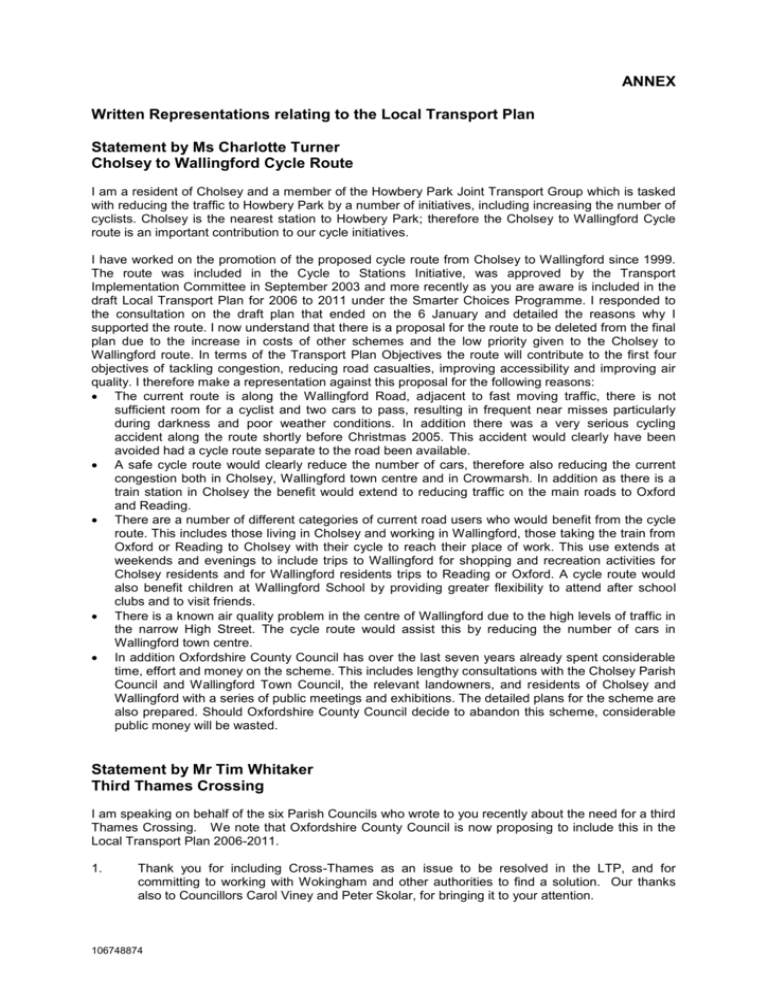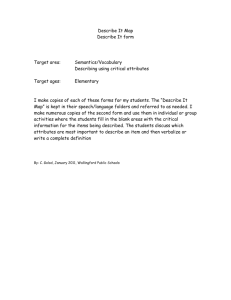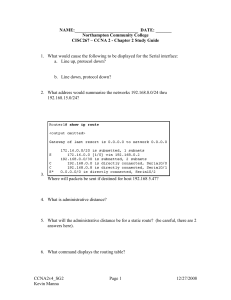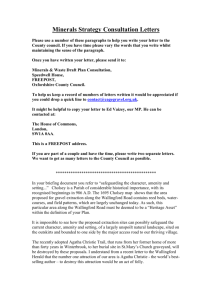as file - Meetings, agendas, and minutes
advertisement

ANNEX Written Representations relating to the Local Transport Plan Statement by Ms Charlotte Turner Cholsey to Wallingford Cycle Route I am a resident of Cholsey and a member of the Howbery Park Joint Transport Group which is tasked with reducing the traffic to Howbery Park by a number of initiatives, including increasing the number of cyclists. Cholsey is the nearest station to Howbery Park; therefore the Cholsey to Wallingford Cycle route is an important contribution to our cycle initiatives. I have worked on the promotion of the proposed cycle route from Cholsey to Wallingford since 1999. The route was included in the Cycle to Stations Initiative, was approved by the Transport Implementation Committee in September 2003 and more recently as you are aware is included in the draft Local Transport Plan for 2006 to 2011 under the Smarter Choices Programme. I responded to the consultation on the draft plan that ended on the 6 January and detailed the reasons why I supported the route. I now understand that there is a proposal for the route to be deleted from the final plan due to the increase in costs of other schemes and the low priority given to the Cholsey to Wallingford route. In terms of the Transport Plan Objectives the route will contribute to the first four objectives of tackling congestion, reducing road casualties, improving accessibility and improving air quality. I therefore make a representation against this proposal for the following reasons: The current route is along the Wallingford Road, adjacent to fast moving traffic, there is not sufficient room for a cyclist and two cars to pass, resulting in frequent near misses particularly during darkness and poor weather conditions. In addition there was a very serious cycling accident along the route shortly before Christmas 2005. This accident would clearly have been avoided had a cycle route separate to the road been available. A safe cycle route would clearly reduce the number of cars, therefore also reducing the current congestion both in Cholsey, Wallingford town centre and in Crowmarsh. In addition as there is a train station in Cholsey the benefit would extend to reducing traffic on the main roads to Oxford and Reading. There are a number of different categories of current road users who would benefit from the cycle route. This includes those living in Cholsey and working in Wallingford, those taking the train from Oxford or Reading to Cholsey with their cycle to reach their place of work. This use extends at weekends and evenings to include trips to Wallingford for shopping and recreation activities for Cholsey residents and for Wallingford residents trips to Reading or Oxford. A cycle route would also benefit children at Wallingford School by providing greater flexibility to attend after school clubs and to visit friends. There is a known air quality problem in the centre of Wallingford due to the high levels of traffic in the narrow High Street. The cycle route would assist this by reducing the number of cars in Wallingford town centre. In addition Oxfordshire County Council has over the last seven years already spent considerable time, effort and money on the scheme. This includes lengthy consultations with the Cholsey Parish Council and Wallingford Town Council, the relevant landowners, and residents of Cholsey and Wallingford with a series of public meetings and exhibitions. The detailed plans for the scheme are also prepared. Should Oxfordshire County Council decide to abandon this scheme, considerable public money will be wasted. Statement by Mr Tim Whitaker Third Thames Crossing I am speaking on behalf of the six Parish Councils who wrote to you recently about the need for a third Thames Crossing. We note that Oxfordshire County Council is now proposing to include this in the Local Transport Plan 2006-2011. 1. Thank you for including Cross-Thames as an issue to be resolved in the LTP, and for committing to working with Wokingham and other authorities to find a solution. Our thanks also to Councillors Carol Viney and Peter Skolar, for bringing it to your attention. 106748874 -22. We understand that the issues are complex. Traffic generation needs to be kept to a minimum. Rural communities need protection from increased through traffic. Reading's ambitions to absorb land need to be kept separate. This will all take detailed work. 3: We look forward to a steady programme of work and public consultation, that will lead to realistic, practical solutions within a reasonable timeframe. We are very happy to bring local resources and knowledge to bear, to help and support OCC in any way we can. 4: Once again, on behalf of many people throughout South Oxfordshire, thank you. Woodstock Town Councillor Emma Jay Woodstock Bypass Scheme Councillor Jay has provided a number of documents which show resolutions previously passed by the Town Council on certain transport issues , which she summarises as follows: Woodstock Town Council does not want a bypass, and requests that the line be deleted, as recommended in the [report CA8]. The issue of a bypass has been a major cause of discord in the community and wasted a lot of time and energy. Its deletion would end this. We are against a bypass as: - it would cause traffic problems for other communities up and downstream of us on the A44, who would then also need bypasses, which would be prohibitively expensive - it would cause environmental damage in the Glyme valley (an area of outstanding natural beauty), - it would bring housing infill in its wake - local businesses fear loss of trade. Instead, we support other measures to relieve our traffic problem, most of which are recommended in the LTP. We welcome the HGV Advisory Route agreed on by OCC’s Freight Quality Partnership and urge the erection of the necessary signage, long promised, as soon as possible. We note that the new FQP map shows the A44 as a minor road, and that Gloucester County Council is considering making the part near Bourton-on-the-Hill into a B road, and request that the A44 be downgraded in the route hierarchy. We welcome the plan to improve flow at the Wolvercote roundabout but feel that further vital improvements to the A40 should not just be left as ‘long term aims’ but made a greater priority.. We would like to see the bus service between Woodstock and Oxford made a ‘Premium Route’ in the medium rather than long term. We would like to see greater encouragement of Freight on Rail. The documents forwarded by Councillor Jay comprise: Resolution of the Town Council in response to the County Council’s Local Transport Plan document 'Moving Forward': [by 9 voted to 3, with one abstention] Woodstock Town Council: urges speedy implementation of the advisory signing of HGV's off the A44 and on to the A40, as promised in Councillor Keith Mitchell's letter to us of 4/1/05, as shown in the excellent new Freight Quality Partnership map, and as already done by Gloucestershire County Council. welcomes the plan to improve traffic flow at the Wolvercote roundabout, but is disappointed that further vital improvements to the A40 are left as 'long term' aims. asks that the line of the Woodstock Bypass be no longer preserved. notes that the new Freight Quality Partnership map shows the A44 as a minor road and requests that it be accordingly downgraded in the next formulation of route hierarchy. asks that the bus service between Woodstock - Oxford be included in the 'Premium Routes' in the medium term. Resolution of the Town Council in response to the County Council’s consultation on the Transport Networks Review (12th April, 2005, Resolution 883) Councillor Mrs E Jay moved a MOTION that:Whereas Woodstock Town Council:1. held a Referendum in Sept 2001 in which the majority of Woodstock electors voted against a bypass for Woodstock; 106748874 -32. has supported the setting up and objectives of ‘A44A' - the group uniting 9 councils along the A44 which has been working to reduce HGV use of the A44; 3. ratified (in July 03 and Sept 04) two substantial policy documents sent by A44A to Oxfordshire County Council, which were further supported by West Oxfordshire District Council, the West Oxon MP David Cameron and all the other 8 town/parish councils along the A44; 4. welcomed a letter of October 2004 from Councillor Keith Mitchell, leader of OCC, staring that the TNR would be recommending the immediate signage of HGV's off the A44 and later consideration of the removal of the A44 from the Primary Route Network; and 5. has now received a request from OCC for its response to the current 'OCC Transport Network Review Summary of Agreed Strategy’ of Oct 04, It now RESOLVED that Woodstock Town Council:a. supports the ‘Route Hierarchy Measures' proposed in the said TNR for the short and medium term; b. supports the recommendation to remove the Woodstock Bypass from the list of retained schemes and to cease protection of the line; and c. write immediately to OCC enclosing a copy of this resolution and stating the Council’s response to the TNR document. The motion was passed by 8 votes to 5. Representations of the A44A Working Group Further copies of the leaflet ‘A Plea to OCC from A44A – a working group for a safer A44’ which was originally presented to the Executive on 21 September 2004 and which included the argument that bypasses on the A44 should not be pursued, together with letters from Chipping Norton Town Council and Yarnton Parish Council expressing support for the Group’s arguments. Statement by Mr Michael Hocken Air Quality BACKGROUND The first Oxfordshire Local Transport Plan 2001-2006 (entitled “Working for a better environment”) declared that “the most important topics which the LTP as a whole addresses are climate change, air quality and health”. It laid down a specific Air Quality Objective (“To meet the National Air Quality Strategy objectives on seven key pollutants”) and a clear Indicator (“Achieve at least the air quality objective levels set out in the National Air Quality Strategy”). The fact is that not only did the County fail to achieve these objectives by the deadlines of 31 December 2004 (particulate matter) or 31 December 2005 (NO 2) in the worst affected areas, but that last month saw the announcement of an impending new Air Quality Management Area, in Abingdon this time. SCRUTINY In December 2004, the (then) Executive endorsed the Recommendation of the Joint Scrutiny Review Group and resolved “that statutory air quality targets would be included in the new Local Transport Plan.” The new Local Transport Plan 2006-2011 - which comes to Cabinet for consideration today - focuses on four Government-determined Objectives, including that of “Better air quality”, and as the authors themselves state “the success of the Plan will be judged in terms of how well these objectives have been met”. CPA (audit assessment) Because of its previously “weak” CPA performance and poor management in outcome delivery under the current Local Transport Plan, Oxfordshire has lost some 25% of its capital allocation for the new Local Transport Plan (in total some £12 million – enough to pay not just for Low Emission Zones in each of the key areas affected, but also for the Marcham by-pass). However, the County does have the chance of obtaining additional “reward funding” from the reserved allocation - if (and only if) it delivers a high quality Plan. That is the challenge you face today. 106748874 -4- The Audit Commission1 has identified significant “weaknesses” in terms of the OCC’s “long term vision of intended outcomes” which “limits connections between key plans e.g. transport and economic prosperity”, and is marked by “loss of focus” and “weak target setting”. The 2004/2005 Local Transport Capital Settlement from Government Office South East noted that: “For air quality, an AQMA has been declared for Oxford City related to a number of roads in the city centre and buildings with facades fronting those roads and Gloucester Green bus station. Your APR did not appear to give detail on this, although we note the aims of meeting National Air Quality targets as part of the Oxford Transport Strategy. We would expect strong reporting next year of how the local transport strategy will contribute to dealing with localised problems in air quality management areas related to local transport.” In light of the above, it is striking to note that the recently published 2005 LTP Annual Progress Report (APR) makes not one single mention of “air quality”. Initial assessment by GOSE in December 2005 of the new Local Transport Plan (which you are considering today) has resulted in a 5% cut in funding for 2006/2007, because a whole series of areas are in need of “substantial improvement”, in particular as regards “the full and active cooperation of all relevant tiers of local authorities involved” (best evidenced by the withholding of the Babtie Environmental Appraisal Report on air quality in Abingdon from the District Council) and because it fails to set “realistic and challenging targets” to “convincingly address current and emerging air quality problems – especially those in Air Quality Management Areas – that are related to local transport (or provide evidence that there are no such problems), and ensure that local transport related air quality problems are addressed by the wider local policy and planning agenda.” The new LTP So what “realistic and challenging targets” does the new Plan propose for air quality? Core target 14 (page 316 of your February 2006 ‘Cabinet Draft’) drops any attempt to meet statutory air quality levels and ‘defines’ the County’s Air Quality Objective as follows: “To reduce the roadside concentrations of NO2 in the central Oxford Air Quality Management Area”; i.e. any reduction will do, however minimal. No targets whatsoever are fixed for the rest of the County. LTP2 and LAQM guidance call for detailed annual targets and a defined trajectory to meet NAQS objectives. The Strategic Environmental Assessment (SEA) that forms an integral part of the new LTP2 submission informs us (page 7) that the County’s “Air Quality Steering Group” is working with partners to develop and implement a regional air quality strategy and will look at transport related means to address AQMAs. Sadly, this Group does not exist, and no work at all is underway to look at traffic related measures County-wide aimed at reducing already identified problems of air quality objective (AQO) exceedences – despite the claim made by E&E to the Environment Scrutiny Committee in September 2005 that there was a “County Council Group that is actively engaged in investigating air pollution.” The “Evaluation Report of Local Authority Air Quality Action Planning” 2 commissioned from Casella Stanger (now Bureau Veritas) by DEFRA was clear on the need for: Preceding technical work Internal working and regional groupings A strategic approach to air quality management and identified the following constraints to effective action planning: 1 2 Delays in responses to consultation and relevant buy-in from upper-tier authorities Effective assessment of impacts annd costs of proposed measures Audit Commission Inspection Report April 2005 CS/AQ/AD102126/RM/2131(Final) May 2004 106748874 -5 Lack of clarity on time-scales One of this report’s chief recommendations was that County Councils be reminded of the LAQM process and the rôle that they are expected to take where they have responsibility for transport planning. The report pointed to “significant problems” with respect to “working with upper-tier authorities (County Councils) and with the Highways Agency.” CONCLUSIONS In light of the above considerations, the OCC Cabinet is urged to: confirm its formal December 2004 commitment to meeting NAQS targets in the final version of the new Local Transport Plan [in line with the undertakings already given to GOSE] duly constitute the Air Quality Steering Group referred to in the Strategic Environmental Assessment annexed to the new Local Transport Plan (and called for in LAQM Guidance) [ and to mandate the said Group to report back to Cabinet within 6 months with a set of clearly costed and integrated measures that will – on the basis of the Oxford AQAP template - form the basis of a new “Air Quality Strategy for Oxfordshire” under the Local Transport Plan] include the issue of “Air Quality” in its “Corporate Risk Management Register” [and mandate the responsible Director to report back to Cabinet within 3 months of today’s meeting with a detailed corporate “air quality” performance assessment] instruct the E&E Directorate to co-operate fully with the Scrutiny Committee in its 12 month Evaluation of the Air Quality Review and the Review of County-wide Air Quality issues [with a view to initiating a more joined-up corporate approach to these issues over the period of the new Local Transport Plan] 106748874





